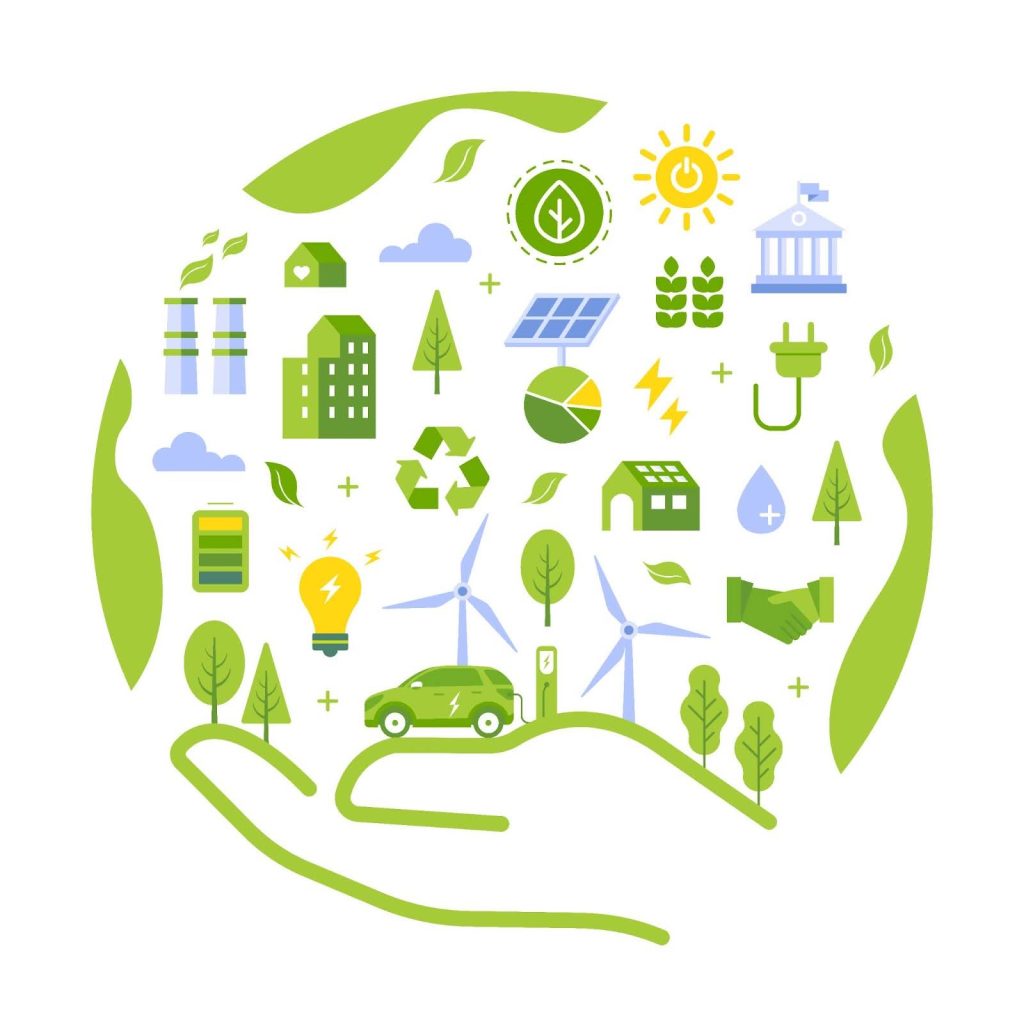
Everywhere you look, companies are branding themselves with labels like eco-friendly, sustainable, fair trade, carbon-neutral, regenerative, ethical, and more. Businesses use these words because consumers are paying attention to environmental and social impacts like never before. But with so many buzzwords floating around, how can we tell if a business is genuinely green and not just using sustainability as a marketing tactic?

It’s Not Just About the Environment
“Green” and “sustainable” are generally used interchangeably when talking about business, so we will focus on those terms here. A green or sustainable business actively reduces its negative impact on the environment. And then it goes a step further—striving to operate in ways that meet present needs without compromising the ability of future generations to meet theirs. In other words, sustainability is about balancing and advancing long-term environmental, social, and economic goals. With that in mind, what does it take to be a truly green business?
Ask an economist or a business owner, and they’ll tell you that the goal of a company is to maximize profit or value. Even nonprofit organizations need financial viability to continue their work. However, green businesses redefine success. They don’t just focus on profit; they take responsibility for their Triple Bottom Line: people, planet, and profit.
This means that green business decisions impact every aspect of operations, from supply chains and materials to employee benefits and marketing strategies. A company that genuinely prioritizes sustainability integrates these considerations into its core business model—not just as an afterthought or a clever PR move.
What Do Businesses Do to Be Green?
A green business doesn’t just talk about sustainability—it integrates it into every aspect of operations. Businesses can be creative in designing sustainability practices and initiatives to adopt, and do best when their approach to being green resonates with their broader business strategy and mission. Here are a few common themes:
- Sustainable Sourcing: Companies committed to sustainability choose suppliers based on ethical, environmental, and social criteria. This might include using responsibly harvested materials, working with fair trade partners, or sourcing from local communities to reduce transportation emissions.
- Sustainable Innovation: Many green businesses develop new products or processes that are both economically viable and environmentally responsible. Examples include biodegradable packaging, low-energy appliances, or zero-waste manufacturing techniques.
- Sustainable Practices: Decisions and details about day-to-day business operations can have a massive impact on sustainability. Common practices include:
- Energy efficiency: Using LED lighting, smart thermostats, and efficient appliances.
- Renewable energy: Transitioning to solar, wind, or other clean energy sources.
- Waste reduction: Recycling, composting, and reducing single-use plastics.
- Water conservation: Implementing low-flow fixtures, rainwater harvesting, or water-efficient production processes.
- Carbon offsetting: Purchasing carbon credits to balance unavoidable emissions. Note, though, that it can be difficult to ensure that this approach has a positive impact on the environment.
- Sustainable Packaging: Eco-conscious companies use minimal, recyclable, or biodegradable packaging materials, reducing plastic pollution and unnecessary waste. While many packaging changes businesses adopt may pass unnoticed by consumers, others, for instance switching from plastic to paper straws, may draw attention.
- Employee Engagement & Green Company Culture: Like any company, green businesses rely on their employees to put in time and effort to make the company successful and advance their corporate mission. Engaging employees at all levels in the business’s green initiatives helps build a sense of purpose, ownership, and accountability for sustainability goals. Here are a few basic strategies businesses can try:
- Offering green employee perks like public transport incentives or bike-to-work programs.
- Providing sustainability training to educate staff on eco-friendly practices.
- Encouraging remote or hybrid work to reduce commuting emissions.
- Inviting employee suggestions for improving sustainability.

- Community Engagement: Businesses connect with local people to gain valuable insights, foster trust, strengthen brand loyalty, and inspire collective action. A green business thrives not just by selling eco-friendly products but by weaving itself into the fabric of its community, working with community members on local initiatives, educating consumers, and encouraging employees to volunteer.
- Diversity, Equity, and Inclusion (DEI): Green businesses embrace DEI by valuing different perspectives, creating fair opportunities, and fostering a culture where everyone feels welcome and empowered. Sustainable innovation thrives on diverse voices and fresh solutions emerge when people from all backgrounds have a seat at the table. Prioritizing DEI enhances problem-solving and builds a more resilient, just, and meaningful sustainable business.
Frameworks That Define Green Business
One way businesses ensure credibility in their sustainability efforts is by aligning with established frameworks and standards. A framework provides a set of goals that can guide a business’s efforts to become more sustainable. Standards are ways to measure progress toward sustainability. Here are some widely recognized frameworks and standards used by businesses around the world:
- UN Global Compact: Companies who voluntarily commit to this initiative strive to implement Ten Principles for sustainable business. The principles cover human rights, labor, environment, and anti-corruption. The UN Global Compact encourages companies to adopt ethical and sustainable policies, emphasizing corporate responsibility at all levels.
- UN Sustainable Development Goals (SDGs): The 17 SDGs provide a roadmap for businesses aiming to contribute to global sustainability. These wide-ranging goals include responsible consumption, climate action, and reducing inequalities. Companies that align their strategies with the SDGs show a commitment to long-term positive change.
- ESG: ESG criteria help ensure that companies are socially responsible and accountable by measuring: E (Environmental) impact, such as waste, pollution, energy use, and greenhouse gas emissions, S (Social) impact, including human rights, labor standards, and community involvement, and G (Governance), such as business ethics, accounting methods, and leadership structure. Impact investing uses ESG to guide investment decisions. Sustainable businesses often choose to report their ESG performance for transparency, using systems and standards developed by the Global Reporting Initiative, International Sustainability Standards Board (ISSB), and others.
- Net Zero: Sustainable businesses that set net-zero targets recognize that the world must drastically reduce GHG emissions to avoid the most extreme consequences of climate change. With net-zero in mind, green companies measure their emissions, make operational decisions that reduce those emissions, and engage in carbon removal activities (such as tree planting) to balance the remaining emissions.
Avoiding Greenwashing: The Pitfall of False Sustainability
Unfortunately, not all businesses that claim to be green actually are. Greenwashing—the practice of misleading consumers about environmental efforts—is a real problem. Companies may highlight one eco-friendly aspect while ignoring harmful practices elsewhere. For example, a company might use recyclable packaging but still rely on fossil fuels for production.
Businesses that want to show their commitment to being green can earn sustainability certifications. These certifications are typically administered by third-party groups and may focus on a specific aspect of sustainability. These are a few widely-recognized certifications you may see in company advertising, sustainability reports, and websites:
- ISO 14001: Offered by the International Organization for Standardization (ISO), ISO 14001 certification indicates that a company is measuring and improving its environmental impact. The certification focuses on standards for environmental management systems.
- B Corp: Companies that earn the B Corp )B Corporation) certification from B Lab, a global non-profit network, undergo a rigorous process to demonstrate high social and environmental performance. B Corps also meet high standards for transparency and governance.
- LEED: Developed by the US Green Building Council , LEED (Leadership in Energy and Environmental Design) certification rates buildings on sustainable design and energy.
- Fair Trade: Companies can signal their attention to ethical sourcing and social responsibility can seek Fair Trade certification for their products. The fair trade label on seafood, produce, or coffee (for example), assures consumers that it was made in alignment with standards to protect the environment and promote sustainable development.
- Green Seal: Green Seal labels on products for cleaning, laundry, and personal care (among others) meet high standards for safer chemical, low-impact manufacturing, responsible sources, and sustainable packaging.
- SBTi: The Science-Based Targets initiative (SBTi) sets emissions goals based on up-to-date climate science. SBTi-certified businesses set net-zero targets and actively work to reduce their GHG emissions.
To spot greenwashing, look for concrete actions, transparency, and third-party certifications. If a company’s sustainability claims are vague or unverified, it’s worth questioning their authenticity.
The Journey to Sustainability: Practice Makes Progress
One crucial takeaway is that there is no such thing as a “perfect” green business. Sustainability is a journey, not a destination. Companies must continuously refine their processes, invest in better solutions, and hold themselves accountable.
Consumers play a key role in this journey too. By choosing to support businesses that prioritize sustainability, we create demand for greener products and services. In turn, businesses see that sustainability isn’t just an ethical choice—it’s also a smart business decision.
If more companies embrace truly sustainable practices, we move closer to a world where business isn’t just about profit, it’s about building a future that benefits everyone: people, planet, and prosperity.
So next time you see a business calling itself “eco-friendly” or “sustainable,” take a closer look. Are they walking the talk, or just painting themselves green? Because real change isn’t about labels, it’s about action.
Ready to lead the future of sustainable business? The Climate-Ready Business master’s program equips you with the skills to turn climate challenges into opportunities, helping businesses grow while making a real impact. Learn how to integrate sustainability into strategy, drive cost savings, mitigate risks, and enhance brand value. Become the leader organizations need to navigate a changing world.
Industry leaders recognize the power of this program to shape the future of business. Brian Komar, VP of Global Sustainability Solutions at Salesforce Foundation, shares his perspective:
“Sustainability is a core value at Salesforce, so I was excited to learn about Unity Environmental University’s expanding curriculum. Their Sustainable MBA in Climate-Ready Business helps equip future leaders with the skills to drive real-world impact by integrating business principles with cutting-edge sustainability strategies.”
This blog was written by Dr. Michele Villinski with the assistance of AI language model ChatGPT (OpenAI, 2025) to brainstorm titles and refine optimization of this work.



